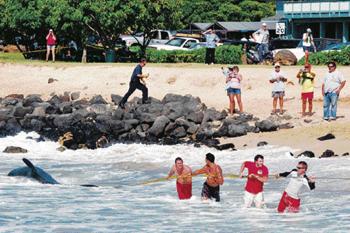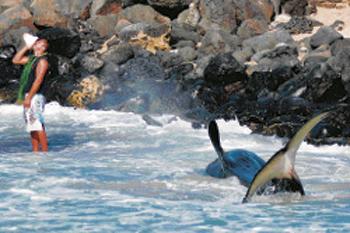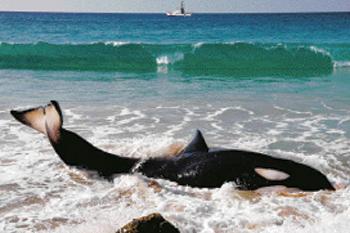PO‘IPU — Veterinarians euthanized an emaciated sub-adult killer whale yesterday morning in the surf along Brennecke’s Beach in Po‘ipu, 12 hours after the marine mammal first became stranded. Officials said the killer whale, a female weighing between 3,000 and 5,000
PO‘IPU — Veterinarians euthanized an emaciated sub-adult killer whale yesterday morning in the surf along Brennecke’s Beach in Po‘ipu, 12 hours after the marine mammal first became stranded.
Officials said the killer whale, a female weighing between 3,000 and 5,000 pounds, appeared very sick. It likely beached itself to keep the airway clear as it became more difficult to stay afloat in its condition, they added.
The orca reportedly thrashed in the water and made calls after first beaching on Tuesday night. But by yesterday morning, it appeared exhausted and rolled with the surf.
David Scofield, National Oceanic and Atmospheric Administration marine mammal stranding coordinator, said the killer whale was so thin that it may have been sick for up to a month prior.
“It was obvious that the animal was in very poor condition,” Scofield told media at an impromptu press conference yesterday. “You could see its ribs.”
Hundreds of spectators watched from behind yellow tape as dozens of volunteers and federal, state and county officials worked.
After the NOAA determined the orca would be a health risk to the wild population if released, two sedation shots were given in the water after 10 a.m.
Once fully sedated, a county excavator was employed to pull the animal out of the water. A final lethal shot was administered on shore to the area around the orca’s heart at 11 a.m., but by then it had gone about 15 minutes without breathing, Scofield said.
Nylon straps were wrapped around the neck and tail, and a second excavator assisted the first in lifting the carcass onto a flatbed truck for transport to an undisclosed location.
The orca’s belly was raw with scrapes, presumably from washing back and forth over the coral. It also had a number of fresh cookie cutter shark bites.
Scofield likened the animal’s appearance to that of a terminally ill human, and said he expects an examination to reveal damage to the muscle and blubber layers.
Asked why the animal wasn’t helped out to sea, Scofield said, “That’s like throwing a drowning man a glass of water. It’s not the right thing to do.”
Throughout the morning, spectators crowded the beach.
Sonya Elizalde drove from Kapa‘a with her four children, three of whom she homeschools, to see the killer whale. While sad to watch, Elizalde said it was educational for her family to witness nature in action.
“It’s all part of life,” she said.
Others commented on how rare the event was for Kaua‘i.
Millie Johnston, a seven-year volunteer with the Kaua‘i Monk Seal Watch program, arrived early in the morning to assist. She said it was “absolutely, without question” the biggest marine mammal emergency she’s ever seen.
“Unfortunately, this is something I’d never want to happen, but we’re here when it does,” Johnston said. “It’s really sad, kind of hard to watch. But it’s a beautiful animal.”
County lifeguards, police, firefighters and parks staff helped NOAA officials and veterinarians; meanwhile, dozens of volunteers ran information, provided water and kept the crowds informed.
“Folks were really exceptionally understanding and respectful,” Jean Souza, Kaua‘i program coordinator for NOAA’s Hawaiian Islands Humpback Whale National Marine Sanctuary, said of the spectators.
A necropsy took place following a blessing of the remains yesterday. Results will not be available for one to two months, officials said.
A pod of killer whales that the sub-adult, estimated at 7 to 12 years old, may have been traveling with was sighted near Nawiliwili Harbor this morning.
Killer whales are not common in Hawaiian waters, with only a handful of sightings each year near Kaua‘i. Scofield said scientists are still trying to determine why they appear in this part of the world.
While there are a half-dozen large whale strandings in Hawai‘i a year, the state’s most recent killer whale stranding was in 2004 off the coast of Lana‘i.




